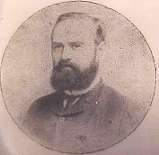

|
|
|
|
History of J.H. Bunnell & Company
based upon a presentation by Dr. Joseph Jacobs at the
1994
Antique Wireless Association Conference
Jesse Bunnell, founder of the company that manufactured telegraph
apparatus and other electrical supplies, was a kind of folk hero, a man about
whom songs and stories should be written. Being born one year before Morse's
invention, provided Jesse with a fertile field to become a champion telegrapher,
wartime operator and establish the company, bearing his name - J.H. Bunnell &
Co. - by the age of 35.
Becoming a messenger boy at age 11, subjected to cannon fire, long hours, hunger,
and privations, he nevertheless found time to stand up for better pay, witnessed
a wired observation balloon ascension, played practical jokes and earned the respect
of the generals and colleagues with whom he worked. Jesse deserves a trip down
memory lane. Let's begin at the beginning.
Jesse Bunnell was born in Massillion, Ohio, in 1843. By age 11, Jesse was
delivering telegraph messages and at 13 he was a full-fledged telegraph operator serving
at offices in Ohio, Pennsylvania, and West Virginia from 1859-61. He set a
telegraph speed record
at age 17 of 32 words per minute as an average, when for a steady two hours, he
forwarded President Buchanan's last message to Congress (including the fancy
words politicians of that day loved to use).
After the attack on Fort Sumter,
in April 1861, Jesse, not yet 18, joined the Union Military Telegraph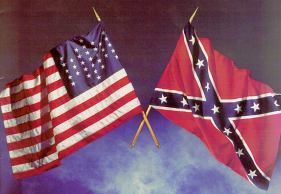 Service (UMTS),
which had been recently organized by Andrew Carnegie, who was an operator
himself at age 15.
Service (UMTS),
which had been recently organized by Andrew Carnegie, who was an operator
himself at age 15.
At the war's start, telegraph operators were the Army's Cinderellas. They were, and
remained, civilians. Their value was not appreciated and they were given very
little support and $60 per month, less than that of a quartermaster clerk. The
operators
were often under fire, as their main duty was to relay troop movement
observations and orders, in part, replacing military couriers.
In December of 1862, Jesse was one of 50 operators who signed and sent a petition to the USMT headquarters asking for an increase in pay and support. Later, as telegraph operators were recognized for their importance, they got merit raises, more regular transport and improved supplies.
Later, however, a group of
operators in one area of the war threatened to resign unless pay was raised to $100 per
month. However, this first telegraph strike was aborted when the operators were threatened with charges
if they resigned en masse instead of individually, as was their right as a
civilian Army employee.
Moving with the Army, the operator would cut his wire keeping a few yards with
his instrument to reattach to the line at the next stop. During battle lulls,
operators were kept busy receiving and relaying
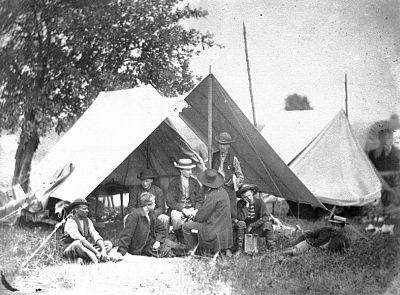 casualty information for the
Army and concerned relatives. Working long hours, operators would often fall
asleep at their instrument; yet always awaken when the sounder clicked their
call sign.
casualty information for the
Army and concerned relatives. Working long hours, operators would often fall
asleep at their instrument; yet always awaken when the sounder clicked their
call sign.
Being young operators, they were not averse to using their skill and wires for
practical jokes. Early in the war, Jesse, "a great wit and very young," was
fired when he pulled a hoax on Wheeling, West Virginia, newspapers about a great
Union naval loss off the "Rip Raps." Of course he had to be fired, but then,
because of his great skill, Jesse was rehired elsewhere at higher wages.
Jesse observed one of the few ascensions of a wired balloon operated by a
balloonist and a telegraph operator to relay troop movements and dispositions.
At first, Jesse, was assigned to the threatened Washington D.C. area in May of
1861, as telegraph service was needed to connect the surrounding encampments and
forts with the War Department and the President. At the end of June, he was sent
to Annapolis as part of a relay with the capitol, but during that time,
operators were "moved from place to place as the occasion required."
Jesse Bunnell's tenure on the relay may have allowed him to serve Lincoln, as history
maintains. Lincoln used the War Department's telegraph office as a refuge
for relative peace and quite. At a desk unofficially reserved for him,
Lincoln wrote part of his Emancipation Proclamation and his second inaugural
address ("... with malice towards none ...") Lincoln sent his last telegram, two
days before his assassination, to Richmond opposing reconvening the Virginia
Legislature.
From about June of 1862 to August of 1864, Bunnell served with the Army of the
Potomac as General McClellan's personal telegrapher, with the sign MC, and with
Sherman's Army of the Cumberland through the bloody battles in Tennessee and on
to Atlanta. Exposure and starvation in the winter of 1864 weakened Jesse
severely, forcing him to resign the 16th of August in 1864 and the UMTS lost one
of its "ablest and bravest operators."
Jesse's return to non-army work from 1864
to 1872 led him to Philadelphia and a partnership with James Partrick, a
successor to Chester, Partrick and Co. Later, from 1875 to 1878,
he worked for
L. G. Tillotson and Co.
In 1878, Jesse created J. H. Bunnell and Co. And in 1879 he hired Charles McLaughlin as a partner in charge of sales and administration, while Jesse concentrated on manufacturing and innovations. Bunnell received a patent on the 15th of February 1881 for his steel lever key. Stamped from one piece of steel, with minor machining required, this key was Bunnell's answer to the loosening of the steel trunion inserted in the brass lever. So successful, the steel lever continues to this day in keys. Early production bore the patent date on the lever. Later, this gave way to a logo containing the letters BUNNELL over a letter S, and with its general acceptance, later levers had no engraving.
|
|
|
In 1888, Bunnell introduced his double speed (sideswiper) key to help telegraphers avoid a "glass arm" (today called carpal tunnel syndrome). The original sideswiper, Style G, did not have spring tension adjustment. Most photographs show the style W, with a spring tensioner.

Bunnell was also heavily into other electrical devices, as noted in an article about the Bunnell Wave Motor - published in 1898 in the "Electrical Engineer." Bunnell, like many other manufacturers, had their castings made for them by specialty houses.
|
|
Bunnell telephone |
In 1899 Jesse Bunnell caught a severe cold, which worsened. He died of heart failure on the 9th of February 1899 at age 56. He was buried in Brooklyn's garden Greenwood Cemetery.
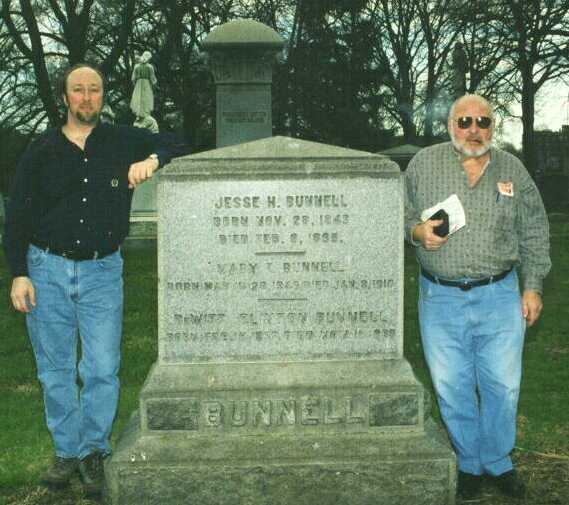
The grave site of Jesse H. Bunnell, surrounded by Dr. Joseph Jacobs (right) and
his
son Matt (left) - the present owner of J.H. Bunnell & Company.
After Bunnell's death, Charles McLaughlin took over the company. In the 1920s J. J. Ghegan became president and introduced many electrical innovations. Ghegan was succeeded by J. G. Doughetery, followed by this wife, who sold the business in the early 1960s to Inso Electronic Products, C. J. Meislich president. In 1989, J. H. Bunnell and Co. was acquired as a division of MNJ Industrials, Matthew Jacobs, President.
J.H. Bunnell & Co., which started in Manhattan,
operated from various locations within that
borough. In the 1930's the company moved its operations to several sites in
Brooklyn and eventually to several locations on Long Island - including Kings Park, where it
is located today.
Starting with telegraph equipment production, Bunnell shortly branched into a huge
variety of electrical items as manufacturer, wholesaler and retailer.
Along with other suppliers, the company produced fire equipment for NYCFD and other fire
departments, burglary alarms, security systems, and medical equipment. From the 1930's through 1950's,
Bunnell supplied
commercial radio and fax transmitters.
Bunnell produced landline telegraph equipment for Postal Telegraph and Western Union - built to either Bunnell's or the purchasing company's specifications. Bunnell continued producing telegraph equipment through 1988 for Mexico and other Latin American countries.
Pre W.W.II, Bunnell was one of the largest telegraph key suppliers. As one of the country's main telegraphic manufacturers, examples of Bunnell telegraph equipment can be found displayed in the Smithsonian's Museum of American History, various railroad museums, and other communications museums.
Company product stamping
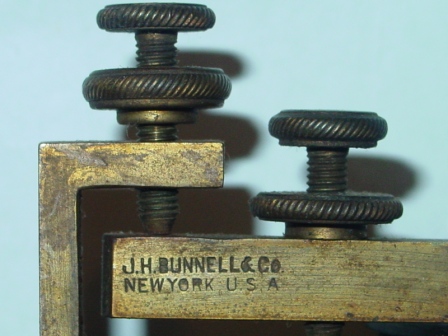
With the introduction of the semi-automatic telegraph key (generally refered to as a bug), Bunnell produced and won the right to use the generic "bug" design. Bunnell, in association with Horace Martin (another famous name in telegraph equipment and founder of the Vibroplex Company) produced these bugs. At one point in time, the Bunnell Company also sold Vibroplex keys.
|
Bunnell "Gold Bug" |
Bunnell Martin Flash Key |
Bunnell manufactured and supplied telegraphy and other electronic equipment for the military from the time of the Spanish American War through the present. Bunnell also made keys for Great Britain's military.
During W.W. II, the Bunnell Company employed 600 people, in a number of manufacturing plants, to produce a variety of electrical and communications items. After .W. II, they continued to supply the military through the Korean War, the Vietnam War, and the Cold War period.
|
|
BC-188-A (Radio Modulator) |
|
|
|
|
J5A Military Flame Proof Key |
|
Originally manufactured by several suppliers, the Navy 26003A Flame Proof key was manufactured to meet the Table of Equipment needs for ships and planes. During the last three decades of production (ending in 1988), J.H. Bunnell & Co. was the sole source of the Flame Proof key. Bunnell Flame Proofs have "CJB-26003A" stamped on them. Other letters indicate different manufacturers.
Navy 26003A Flame Proof key
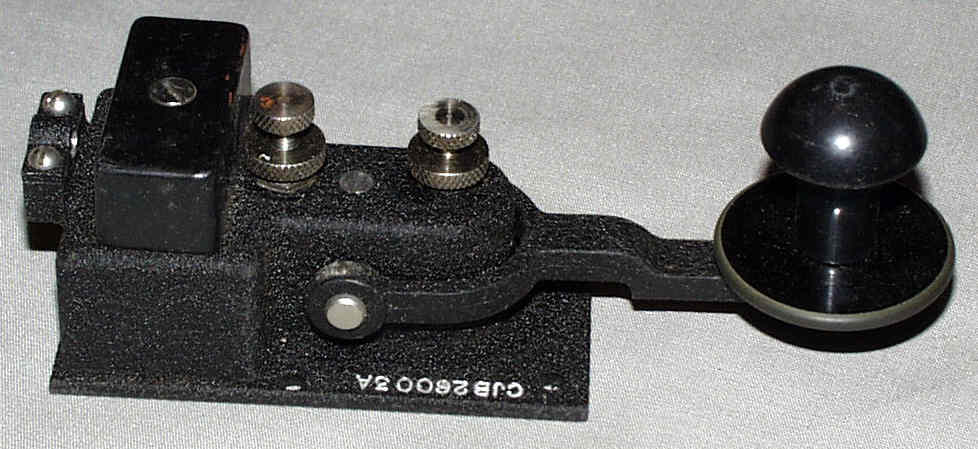
The Navy Flame Proof was a solidly built, smooth
operating key, that later proved very popular with amateur radio operators. New
original stock (NOS) Flame Proof keys are currently available at:
Purchase
a Navy Flame Proof key.
In the 1890's, Bunnell introduced fully functional miniature versions of their keys, sounders, and KOBs (key on a board) selling them as tiepins or with a bale for use as a watch fob.
These beautiful miniatures weren’t just novelties, but were used in noisy environments, for private message reception, and were even rumored to be used by spies!The miniatures were sold to ardent telegraphers and presented as special awards. Among the recipients: Jesse Bunell's Civil War boss, Andrew Carnegie, at a 1908 Telegraphic dinner to RCA's Sarnoff (of Titanic fame), other radio luminaries. In 1954 President Eisenhower also received a miniature. As a collectible, the miniatures are extremely rare and desirable.

In addition to its current sales to industry and the military, the J.H. Bunnell & Co. has issued a new limited edition of their key, sounder, and KOB as a forerunner to production of other sought after telegraph items.
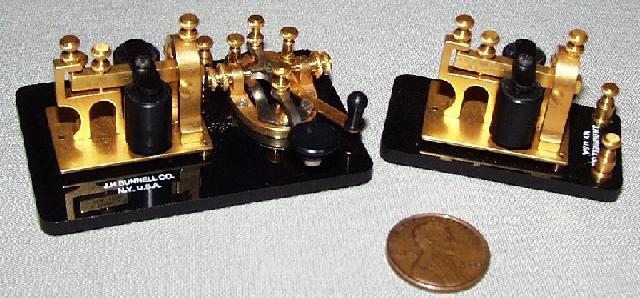
Special request serial numbers are being issued on a first come basis for this limited production run. Order forms are available on request to the company at: J. H. Bunnell, 80 Locust Drive, Kings Park, NY 11754, USA , by FAX 631-361-2173, or by email jhbunnell@optonline.net
Time-Line of Bunnell & Co.
History of J.H. Bunnell & Company
A Telegraph Office
Other Telegraph Instruments J. H. Bunnell Co., 80 Locust Drive, Kings Park,
NY 11754
1868-72 Chester, Partrick & Co. (w/ Bunnell) 38 S. Fourth St., Philadelphia, PA
1872-75 Partrick, Bunnell & Co., 38 S. Fourth St., Philadelphia,
PA
1874-75 22 Dey St., New York, NY
1876-78 Bunnell, (w/Tillotson)
1878-80 Bunnell, J.H. & Co., 70 Cortland St., New York, NY
1880-1885 106-108 Liberty St., New York, NY
1884 112 Liberty St., New York, NY
1890 76 Cortland St., New York, NY (factory at 136-138 W. 24th St., New York, NY)
1900 20 Park Place, New York, NY
1901 110-116 Beekman St., New York, NY
1915-1924 32 Park Place, New York, NY
1926 32 Park Place, New York, NY (factory at Pearl St. and Prospect St., New York, NY)
1941 215 Fulton St., New York, NY
1949-1953 215 Fulton St., New York, NY (factory at 81 Prospect St. Brooklyn, NY)
1960-1963 920 Essex St. Brooklyn, NY
1963-1968 Valley Stream, NY
1968-1988 Bunnell, J.H. & Co., 166 Babylon Tpk., Roosevelt, NY (a Div. INSO Electronic Products)
1989-Pres Bunnell, J.H. & Co., 80 Locust Drive, Kings Park, NY
Learning to be a Telegrapher
The Morse and Continental Codes
The Lineman's Job and Equipment
Telegraphy Publications
Telegraphy Links
Purchase a Mini-Key
Purchase a Navy Flame Proof key
Home
631-360-1967 - FAX 631-361-2173 - jhbunnell@optonline.net